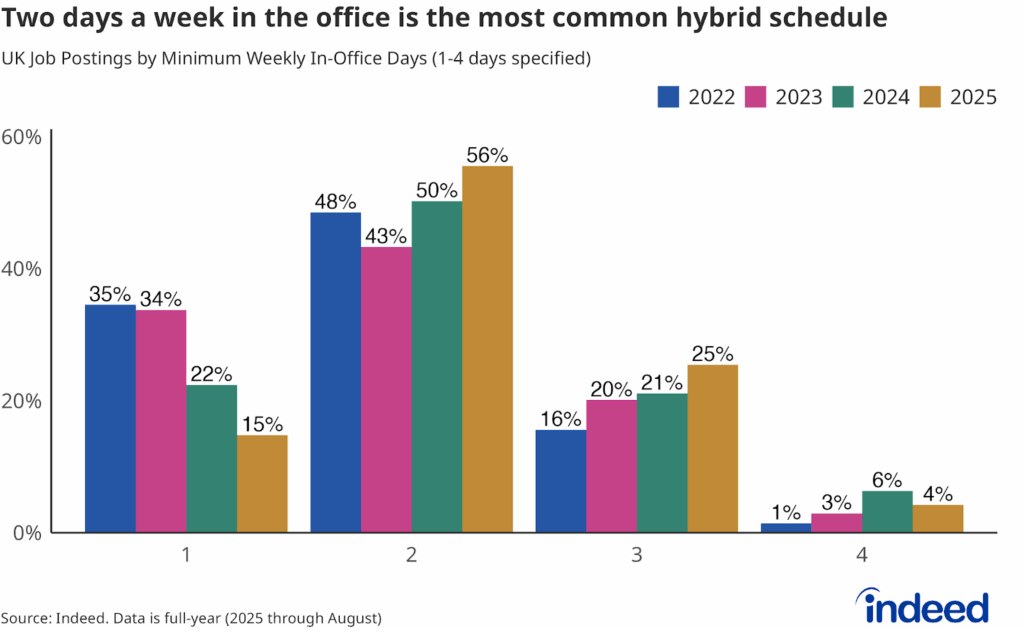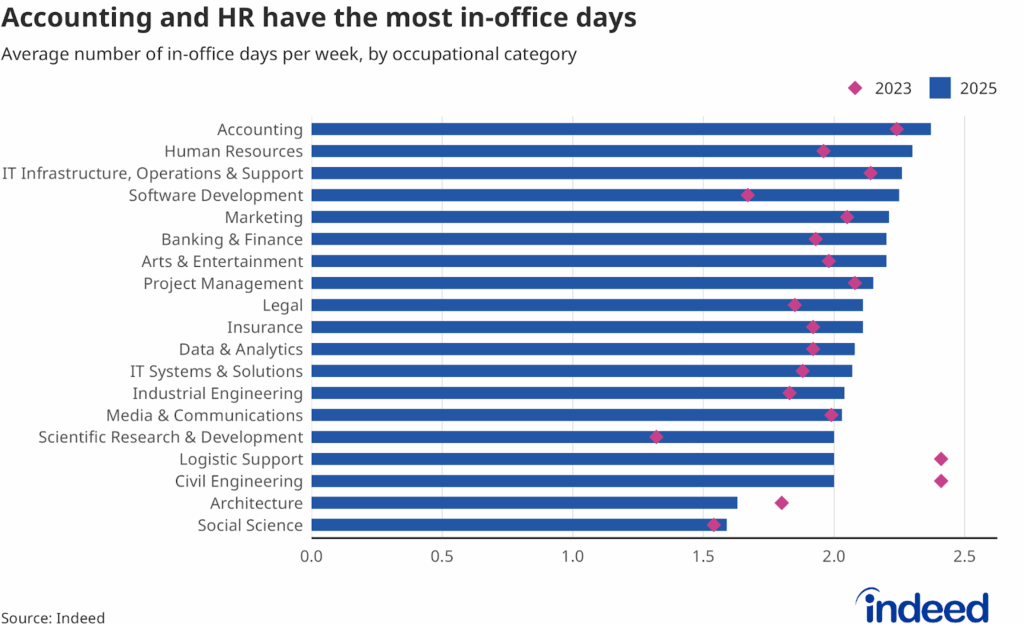- Hybrid work patterns are shifting as UK employers tighten office attendance requirements.
- Just 15% of hybrid job postings require only one office day per week in 2025, down from 34% two years ago.
- The most common minimum is now two office days (56%, up from 43% in 2023).
- A further 25% require at least three days, up from 20% in 2023.
- Accounting, human resources and software development have the highest average number of minimum in-office days.
- Social science and architecture jobs require relatively few in-office days.
More than a quarter of UK adults had access to hybrid work during Q1, a lasting workplace legacy of the pandemic that has survived several high-profile return-to-office calls. The share of UK postings mentioning remote and/or hybrid work has remained fairly stable at around 15% for several months, near all-time highs.
However, employers are tightening these hybrid arrangements, requiring more frequent office attendance than before. Just 15% of hybrid job postings asking for a specific number of days in office specified a minimum of one day per week in 2025 (through August), down from roughly one-third in 2023. The most common arrangement is two days (56%, up from 43% two years ago). One-quarter of postings now indicate a minimum of three days a week in the office, up from 20% in 2023. And only 4% of postings offering some form of remote or hybrid work ask for a minimum of four days a week in the office.
This analysis examined both the number of days required in the office and the number of days permitted from home.

Accounting and human resources have the highest average number of in-office days
On average in 2025, the occupation with the highest number of required office days is accounting (2.4), followed by human resources (2.3) and IT infrastructure, operations & support (2.3). Perhaps surprisingly, in an industry known for being relatively remote-friendly, the typical hybrid software development job requires 2.3 days in office, up 0.6 percentage points over the past two years to go from fourth-lowest to fourth-highest in this list. That was the second-largest increase behind scientific research & development (0.7ppts).
Almost half (48%) of UK software development jobs mention remote and/or hybrid work, the highest of all occupations tracked by Hiring Lab. The increase in required office days could reflect employers wielding more leverage in a subdued market for tech talent, and/or wanting to promote greater in-person collaboration.
Occupations with fewer in-office days (on average) include social science and architecture (both 1.6). The latter is one of only three occupations to have seen a decline in the average number of in-office days, alongside civil engineering and logistic support.

How does this compare with worker preferences?
Surveys of UK workers commonly suggest that 1-2 days a week in the office is their most favoured arrangement. The current balance, therefore, appears slightly higher than what employees desire, though not drastically so.
While some employer surveys suggest companies would like to further boost office attendance, there have also been warnings that some employees would consider leaving if forced back to the office.
Several years after the pandemic-driven shift to remote work, hybrid arrangements remain in flux, and there remains substantial variation in employer policies. Market conditions continue to have a bearing, while employers may feel that the current softness of the labour market has strengthened their hand, leading some to perhaps push for greater on-site attendance.
Methodology
This analysis was based on job postings on Indeed in the UK between January 2022 and August 2025. Postings requiring a specific number of minimum office days (between 1 and 4 per week) were identified and included in the dataset.
Occupations that are less office-based, defined as having less than 25% of postings mentioning remote/hybrid flexibility according to Indeed Hiring Lab’s tracker as of 31 July 2025, were excluded from the analysis.
Postings were identified using a text matching approach in job descriptions, based on commonly used wordings to indicate minimum office attendance expectations. This was based on either explicit references to in-office days per week, references to permitted work-from-home days, percentage-based statements or inferred from monthly office attendance requirements. References to initial training periods where there was a different number of in-office days were identified and ignored, with only the eventual expected schedule extracted.


